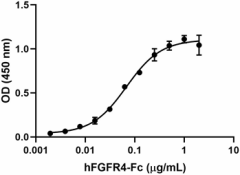- Regulatory Status
- RUO
- Other Names
- Fibroblast growth factor 21, FGF21

-

Recombinant human FGFR4-Fc (Cat. No. 752502) binds to immobilized recombinant human FGF-21 in a dose-dependent manner. The ED50 for this effect is 0.04 – 0.2 µg/mL. -

Human FGF-21 induces NIH3T3 proliferation in the presence of recombinant mouse klotho beta and heparin, in a dose-dependent manner. BioLegend’s human FGF-21 product was compared side-by-side to a leading competitor’s equivalent product.
| Cat # | Size | Price | Quantity Check Availability | ||
|---|---|---|---|---|---|
| 553804 | 25 µg | $223.00 | |||
Select size of product is eligible for a 40% discount! Promotion valid until December 31, 2024. Exclusions apply. To view full promotion terms and conditions or to contact your local BioLegend representative to receive a quote, visit our webpage.
FGF-21 is an atypical member of the FGF superfamily and functions as an endocrine hormone. It is mainly secreted by the liver but also by other tissues including adipocytes, pancreas, and skeletal muscle. It can act not only locally but also can travel through the circulatory system and function as an endocrine hormone. FGF-21 signals through a complex formed by classic FGF receptors and the coreceptor β-Klotho. Although it has been shown that FGF-21 can bind all FGFR isotypes, in vitro studies have shown that FGF-21 prefers FGFR1c/β-Klotho complex. Since the expression of β-Klotho is restricted to several tissues including liver, adipose tissues, pancreas, CNS and testes, it is believed that these tissues are the major sites of FGF-21 action. In liver, FGF-21 can induce gluconeogenesis, fatty acid oxidation, triglyceride degradation, and ketogenesis. It has also been reported that PGC-1α, a key regulator of mitochondrial energy metabolism, can be induced by FGF-21. In adipose tissue, FGF-21 regulates lipolysis and stimulates glucose uptake independent of insulin. In pancreatic islets, FGF-21 can increase insulin expression. Transgenic mice overexpressing FGF-21 are protected from diet-induced obesity; therefore, FGF-21 has been considered a promising potential therapy for the treatment of obesity-related disorders. FGF-21 can cross the blood-brain barrier and FGF-21 has been shown to regulate peripheral metabolism and circadian behavior by acting on the nervous system.
Product Details
- Source
- Human FGF-21, amino acids His29-Ser209 (Accession# NP_061986) with an N-terminal Met and 5-His tag, was expressed in E. coli.
- Molecular Mass
- The 187 amino acid recombinant protein has a predicted molecular mass of approximately 20 kD. The DTT-reduced and non-reduced protein migrate at approximately 20 kD by SDS-PAGE. The predicted N-terminal amino acid is Met.
- Purity
- >95%, as determined by Coomassie stained SDS-PAGE.
- Formulation
- 0.22 µm filtered protein solution is in PBS.
- Endotoxin Level
- Less than 0.01 ng per µg cytokine as determined by the LAL method.
- Concentration
- 10 and 25 µg sizes are bottled at 200 µg/mL. 100 µg size and larger sizes are lot-specific and bottled at the concentration indicated on the vial. To obtain lot-specific concentration and expiration, please enter the lot number in our Certificate of Analysis online tool.
- Storage & Handling
- Unopened vial can be stored between 2°C and 8°C for up to 2 weeks, at -20°C for up to six months, or at -70°C or colder until the expiration date. For maximum results, quick spin vial prior to opening. The protein can be aliquoted and stored at -20°C or colder. Stock solutions can also be prepared at 50 - 100 µg/mL in appropriate sterile buffer, carrier protein such as 0.2 - 1% BSA or HSA can be added when preparing the stock solution. Aliquots can be stored between 2°C and 8°C for up to one week and stored at -20°C or colder for up to 3 months. Avoid repeated freeze/thaw cycles.
- Activity
- Recombinant human FGFR4-Fc (Cat. No. 752502) binds to immobilized recombinant human FGF-21 in a dose-dependent manner. The ED50 for this effect is 0.04 – 0.2 µg/mL.
- Application
-
Bioassay
- Application Notes
-
BioLegend carrier-free recombinant proteins provided in liquid format are shipped on blue-ice. Our comparison testing data indicates that when handled and stored as recommended, the liquid format has equal or better stability and shelf-life compared to commercially available lyophilized proteins after reconstitution. Our liquid proteins are verified in-house to maintain activity after shipping on blue ice and are backed by our 100% satisfaction guarantee. If you have any concerns, contact us at tech@biolegend.com.
Antigen Details
- Structure
- Growth factor
- Distribution
-
Liver, adipose tissue, pancreas, and muscle.
- Function
- FGF-21 is an important regulator of glucose and lipid metabolism. FGF-21 expression is regulated by PPARα and PPARγ in liver and adipose tissues respectively. Expression of FGF-21 is regulated by insulin/Akt in muscle tissue.
- Ligand/Receptor
- FGFRs/β-Klotho.
- Cell Type
- Embryonic Stem Cells, Hematopoietic stem and progenitors, Mesenchymal Stem Cells, Neural Stem Cells
- Biology Area
- Cell Biology, Neuroscience, Stem Cells, Synaptic Biology
- Molecular Family
- Cytokines/Chemokines, Growth Factors
- Antigen References
-
1. Nishimura T, et al. 2000. Biochim Biophys Acta. 1492:203.
2. Kharitonenkov, et al. 2013. Mol. Metab. 3:221.
3. Luo Y, et al. 2013. Front. Endocrinol. 4:194.
4. Cheung BM, et al. 2014. Expert Rev. Cardiovasc.
5. Kharitonenkov A, et al. 2008. J. Cell Physiol. 215:1.
6. Bookout AL, et al. 2013. Nat. Med. 9:1147.
7. Potthoff, et al. 2009. Proc. Natl. Acad. Sci. 106:10853. - Gene ID
- 26291 View all products for this Gene ID
- UniProt
- View information about FGF-21 on UniProt.org
